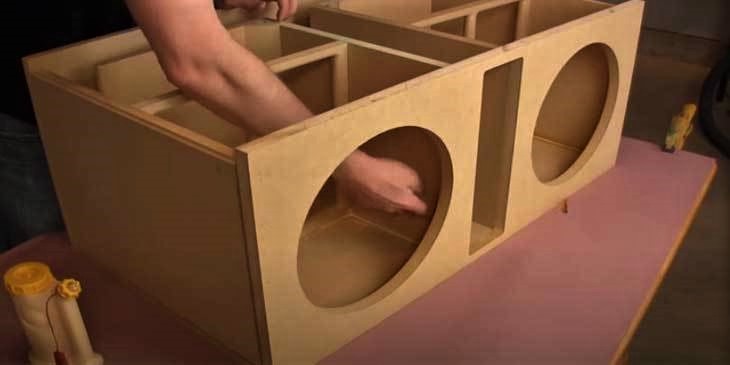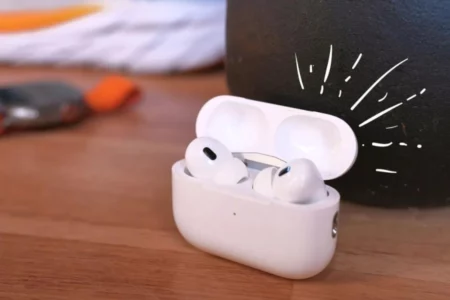A typical subwoofer is a device built to replicate low-pitched sound frequencies called s and sub-bass, which are lower in frequency than a woofer can produce. For consumer devices, the usual frequency range for a subwoofer is around 20–200 Hz, below 100 Hz for professional live sound, and below 80 Hz in THX-certified systems.
Subwoofers are not utilized on their own; they’re meant to supplement the low-frequency range of loudspeakers that cover the higher frequency bands. While technically, the term “subwoofer” solely refers to the speaker driver, it is commonly used about driver housed in a loudspeaker box.
A subwoofer box, often known as a sub box, can help contain all of the vibrations from the drivers, preventing mechanical damage. A properly sized subwoofer enclosure can also provide excellent bass extension while reducing sound interference.
So, rather than making your subwoofer box from scratch, you should go with a factory-made box that is widely available for the most common types of automotive subwoofers. Here’s a quick guide to selecting the ideal sub-box for your car.
How To Fix: Car Subwoofer is Not Working?
How To Select a Subwoofer Box Design?
While selecting a subwoofer box design, pay close attention to the engineer’s suggested box size, especially when your vehicle is small. The box audio determines how large your box must be for the subwoofer to perform at its best.
Make sure the design is suitable for your car’s space and aesthetic. For smaller cars, choose smaller subwoofer dimensions that can fit easier and look good and provide an adequate volume rather than blasting your car with pounding bass.
Complete Guide: Are Subwoofers Worth it for Music in Cars?
Building a Custom Subwoofer Box
When building a subwoofer box, keep in mind that it needs to be as solid as possible to avoid flexing.
While thinner material should not provide an issue for tiny sealed boxes, building a vented or bandpass box may present greater challenges.
The most commonly recommended thickness of the material is 34″, or 0.75′′. You can use 12″ or 5/6′′ thick wood for smaller subwoofers like 6.5′′ or 8′′,
What is the most significant material for a subwoofer box, you may be wondering? Well, there are a few choices, so let’s go over the most popular ones:
1) MDF Sheet:
The most common material for basic enclosures is MDF (Medium Density Fiberboard). This engineered wood is extremely robust and dense, which improves audio quality.
MDF is ideal for any location with high humidity or harsh winters because it does not warp or expand. It also doesn’t cause any sound distortion due to its thickness.
MDF has one important drawback, which is its weight. While it may not be important for smaller boxes (unless you carry it back and forth every day), it is critical for complex multi-driver installations.
2) Plywood:
One typical material for subwoofer boxes is Plywood. Because it is less dense than MDF, it is lighter yet still sturdy enough to resist rattling.
3) Fiberglass:
Fiberglass is a great material for light constructions, and it’s frequently employed for highly tailored designs. So, if you want to use your entire trunk to house numerous subwoofers, fiberglass is the way to go, and the results will be spectacular.
Use of Speaker Wire
Generally, a wire gauge of 12 to 16 should be used for a subwoofer, depending on the power. Use a narrower gauge if you’re driving hard.
Keep in mind that the wire gauge within the box should never exceed that of the wire connecting the amplifier to the enclosure.
Subwoofers need a lot more power than speakers do; thus, their wiring should handle it. All connections inside the box between the amplifier and the terminal in the enclosure should be sturdy.
Subwoofer Box Design
To figure out what size your subwoofer box should be, follow these steps:
– How Deep Your Box Should Be?
2 inches should be added to the depth of your subwoofer. This is the box’s minimum depth measurement.
– Box’s Minimum Measurements:
To establish the minimum height and breadth for the front of the subwoofer enclosure, measure the diameter of the boundaries of the subwoofer or consult the manual about mounting a subwoofer that may be having the owner’s manual. If you intend to install a grille, make sure to account for any extra room that you might need.
– How Much Room Your Car Has?
Take measurements of the top, sides, and the depth of the total room in your vehicle in which you want to install your subwoofer box. Next, you’ll have to figure out the depth of the box’s roof, and the base fit needs to be wedge-shaped to fit.
– Sketch Your Box:
It’s time to draw your customized subwoofer box design using all of the measurements you’ve obtained on paper. Although the enclosure depicted in this guide is shaped like a rectangle, you might discover that a wedge-shaped box fits better in your
– Determine the Subwoofer Box Dimensions:
The box’s external dimensions were determined using the techniques outlined above. Deduct the width and strength of the Plywood used to make the subwoofer box and get the internal volume. If you’re using 3/4″ MDF, deduct 2 x 3/4″, or 1-1/2″, from each dimension.
– Define the Cubic Inch Volume of Box:
The interior volume of the enclosure can be calculated using the following calculation regarding the internal dimensions: Cubic Volume = Height x Width x Depth.
Because the wedge box has two depth dimensions, we must first determine the average depth before calculating the volume. To calculate the average depth, multiply the two depth values by 2.
You’ll need to convert the internal volume from cubic inches to cubic feet because most manufacturers specify the recommended box volume in cubic feet. Divide the cubic inches by 1,728 to get the answer.
– Match the Volume of Your Box to the Sub’s Specs:
Match the volume of the box you drew to the manufacturer’s recommendations. If it’s too big or too little, make tiny tweaks to one dimension until the inside volume of your box approximately fits the manufacturer’s recommendation. Manufacturers frequently recommend a variety of box volumes. With a box that is anywhere within the specified range, you can achieve good results.
– Calculate External Dimensions:
After you’ve determined the right interior dimensions, remove the 1-1/2″ you deducted in step 5 to get the accurate measurement values for the outer part of the enclosure. Once you’ve double-checked that these measurements will adjust and fit easily in your vehicle, you can now start building.

Related Blog: How to Break In a Subwoofer Properly?
How to Make a Subwoofer Box?
Place the Wire Terminal
When you’ve almost built the box, the next step is to put a subwoofer terminal in the hole. To ensure no undesired air leaks, I use small 1/2′′ screws and silicone from the inside.
Fill the Enclosure’s Inside with Polyfill
Start filling the box with polyfill after placing wire inside. Filling a bass box ensures that any loose wire inside won’t rattle against the walls. However, the nicest effect I noticed is in the sound. The bass is deeper because the polyfill absorbs the sound.
Install and Test the Subwoofer
Next is to mount the speaker to the enclosure and test the subwoofer once the box is constructed, sealed, and linked to the speaker.
It’s a good idea to put a rubber gasket on the bottom side of the speaker before screwing it into the box. This will prevent air from escaping out of the cage.
Make sure there is no gasket sticking out of the mounting hole before inserting a subwoofer. I use 1′′ screws to secure a subwoofer. However, because the front panel is 1.5′′ thick, don’t use longer screws; it’s better if the screws don’t go all the way in.
Install a Bass Box in your Car
Take the box to the car and connect a speaker wire to the terminal before turning on the radio. Don’t go overboard with the loudness at first.
You may need to tweak the filters in the amplifier and crossover to obtain the best results, but we are confident you will be delighted with the result if you follow the steps carefully.
How to Cover a Subwoofer Box in Carpet?
We don’t recommend using any fancy gear to cover a subwoofer box with a carpet; I need a razor blade, spray adhesive, and a metal ruler. If you want to finish your subwoofer box with various materials, you can find more information about it online.
Cut the carpet to the correct size after measuring it. If you’re using the carpet, the First Step is to precut it to fit the box’s dimensions. Next, the carpet should be used to cover the enclosure.
We can say with confidence that if you follow our guide step by step, it is very easy for you to build a subwoofer box on your own in no time. All the relevant information about custom subwoofer box design and how to build a subwoofer box are given in this guide made just for you.
Final Vedict





